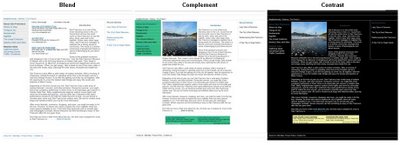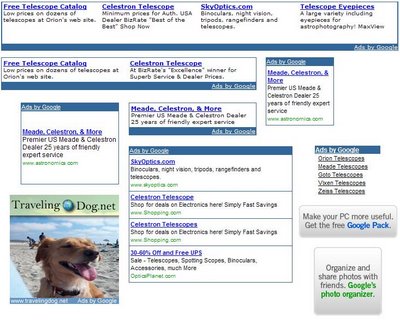You've been slowly and steadily attracting new visitors to your site, you've crawled up the search engine rankings and the AdSense clicks have started to appear. Just as you're on a roll, having accumulated only a few dollars short of your first AdSense pay check, you get the dreaded email from Google:
Hello Joe Bloggs,
It has come to our attention that invalid clicks and/or impressions have been generated on the Google ads displayed on your site(s). Therefore, we have disabled your Google AdSense account. Please understand that this was a necessary step in order to protect the
interest of the AdWords advertisers.
A publisher's site may not have invalid clicks or impressions on any ad(s), including but not limited to clicks and/or impressions generated by:
- a publisher on his own webpages
- a publisher encouraging others to click on his ads
- automated clicking programmes or any other deceptive software
- a publisher altering any portion of the ad code or changing the layout, behaviour, targeting or delivery of ads for any reason
These or any other such activities that violate Google AdSense Terms and Conditions and programme polices may have led us to disable your account. The Terms and Conditions and programme polices can be viewed at:
https://www.google.com/adsense/localized-terms?hl=en_GB
https://www.google.com/adsense/policies?hl=en_GB
Publishers disabled for invalid click activity are not allowed further participation in AdSense and do not receive any further payment. The earnings on your account will be properly returned to the affected advertisers.
If you feel that this decision was wrong and can maintain in good faith that the invalid activity was not due to your actions or negligence or those of the people that you are responsible for, such as employees and family members, you may appeal against the closing of your account. To do so, please contact us only through this form:
http://www.google.com/support/adsense/bin/request.py?contact=invalid_clicks_appeal&hl=en_GB
If Google decides to evaluate your appeal, we will do our best to inform you quickly and will proceed with the appropriate action as necessary. If we have reached a decision on your appeal, subsequent or duplicate appeals may not be considered.
Yours sincerely,
The Google AdSense Team
So what do you do next? Google has very good click fraud detection methods and if they say they have detected invalid clicks and/or impressions you can be fairly confident this is accurate. Probably 99% of AdSense publishers who receive this message have been correctly suspended for violating the AdSense
terms and conditions, although most won't admit to it. They have either clicked on their own ads, asked someone else to, or had a 'helping hand' from their friends, colleagues or relatives. So what of the other 1%? The 1% of AdSense publishers suspended from the program because of the actions of an unscrupulous business rival, mischievous trouble-maker or genuine error or omission on the part of Google? If you fall in this 1% you face a difficult challenge - you need to convince Google, who get it right 99% of the time, that they've made a mistake this time. This isn't an easy task, but it is possible.
If you find yourself suspended for invalid clicks and/or impressions, and you genuinely believe you've done nothing wrong, here's what you have to do:
- Complete the appeal form as fully and accurately as possible. It is a web form so once you send it the data is gone. Be sure to keep a copy of what you write.
- Pay particular attention to the last 2 boxes of the appeal form: "Any relevant information that you believe would explain the invalid click activity we detected" and "Any data in your weblogs or reports that indicate suspicious IP addresses, referrers or requests". You need to think carefully about what you write here. It needs to be well structured and well mannered. These boxes are your opportunity to explain the suspicious activity and offer evidence to prove you weren't responsible. The importance of keeping accurate visitor logs for your sites can not be over-emphasised. You might like to supply visitor log entries, suspicious IP addresses, whois records or ISP records - the more evidence you provide the easier it will be to convince Google of your innocence.
- Be honest in your appeal. If your six year old nephew went berserk with the mouse on your AdSense ads tell them that. If you were tidying up a web page and you accidentally clicked an ad own up to it.
- Be polite in your appeal. Hopefully it will be read by a real person, although this is increasingly unlikely with Google. A person is more likely to read and consider a polite appeal form than one which is rude and insulting. Remember that the person considering your appeal form has probably read a hundred offensive forms already that day - you are at an advantage if you buck that trend.
- Conclude your appeal form by doing a little grovelling. Tell them how much you respect the AdSense program, how you understand they need to protect their advertisers, how you would be happy for any revenue earned by invalid clicks to be refunded to the advertisers concerned and that you are more than happy to assist them in any further investigation.
- After you've submitted the appeal, just sit and wait a few days for them to consider it. Within a few days you will get an automatic email reply, nearly always as follows:
Hello Joe Bloggs,
Thank you for your appeal.
After receiving your response, we re-reviewed your account data thoroughly. We have reconfirmed that invalid clicks were generated on the ads on your site in violation of our Terms and Conditions and programme policies.
https://www.google.com/adsense/terms
https://www.google.com/adsense/policies
We have implemented these policies to help ensure the effectiveness of Google ads for our publishers as well as our advertisers. According to our policy on this matter, we are unable to reinstate you into the programme.
Please bear in mind that subsequent or duplicate appeals may not be considered and you may not receive any further communication from us. We appreciate your understanding.
Sincerely,
The Google AdSense Team
- Now for the best bit - you need to complete the appeal form all over again! That's why you need to keep a copy of your first appeal. Do not be put off by the "Please bear in mind that subsequent or duplicate appeals may not be considered and you may not receive any further communication from us." Complete the second appeal form exactly as you did the first. Obviously include any new information that might help you prove your innocence. Google will know you have already appealed. They will also see that your second appeal form agrees with the first, that you remain adamant of your innocence and that you are keen to stay involved with AdSense - all of these are points in your favour.
- Hopefully a few days later your efforts will be rewarded by your account being reinstated, but this is still by no means certain. At least you've tried your best and can start looking for another contextual advertising service.
Remember that prevention is much better than cure. Minimise your chances of being suspended by keeping an eye on your AdSense account and visitor logs - if you notice anything suspicious, or accidentally click your own ad report it to AdSense support immediately. Normally they are quite understanding.





